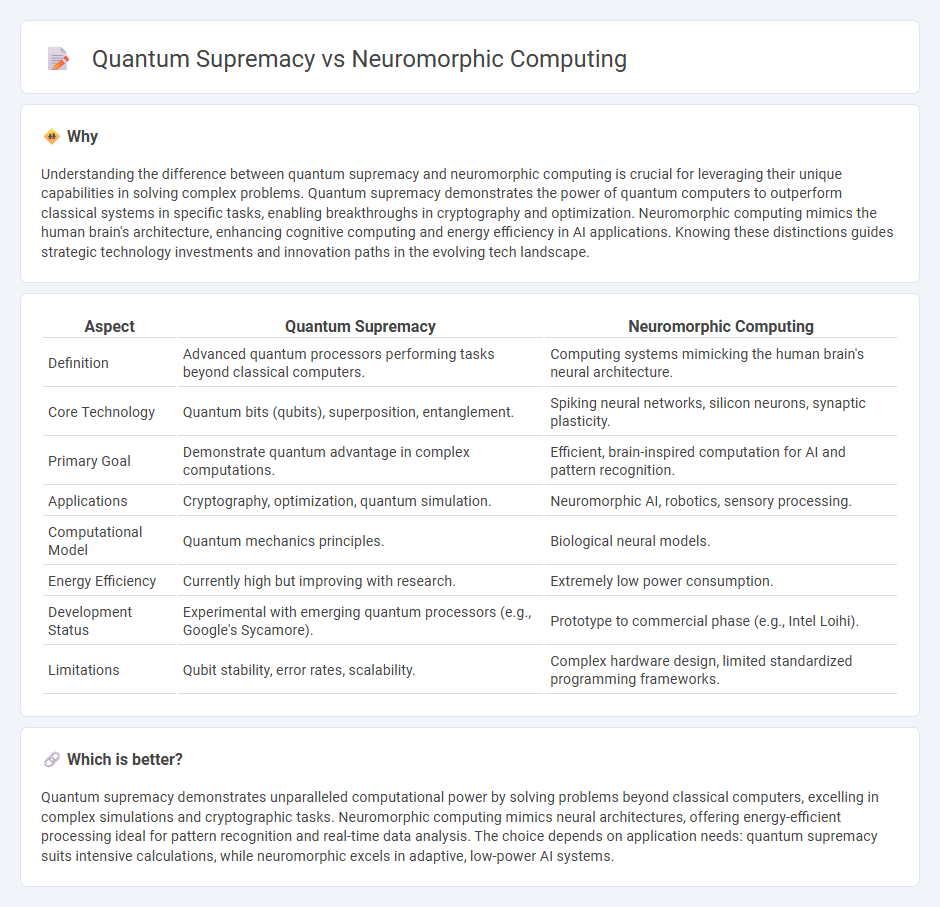
Quantum supremacy represents a breakthrough in computing power by utilizing quantum bits to solve complex problems exponentially faster than classical computers. Neuromorphic computing mimics the neural architecture of the human brain to achieve energy-efficient, adaptive learning and processing capabilities. Explore the distinctions and implications of these cutting-edge technologies to understand their potential impact on the future of computation.
Why it is important
Understanding the difference between quantum supremacy and neuromorphic computing is crucial for leveraging their unique capabilities in solving complex problems. Quantum supremacy demonstrates the power of quantum computers to outperform classical systems in specific tasks, enabling breakthroughs in cryptography and optimization. Neuromorphic computing mimics the human brain's architecture, enhancing cognitive computing and energy efficiency in AI applications. Knowing these distinctions guides strategic technology investments and innovation paths in the evolving tech landscape.
Comparison Table
| Aspect | Quantum Supremacy | Neuromorphic Computing |
|---|---|---|
| Definition | Advanced quantum processors performing tasks beyond classical computers. | Computing systems mimicking the human brain's neural architecture. |
| Core Technology | Quantum bits (qubits), superposition, entanglement. | Spiking neural networks, silicon neurons, synaptic plasticity. |
| Primary Goal | Demonstrate quantum advantage in complex computations. | Efficient, brain-inspired computation for AI and pattern recognition. |
| Applications | Cryptography, optimization, quantum simulation. | Neuromorphic AI, robotics, sensory processing. |
| Computational Model | Quantum mechanics principles. | Biological neural models. |
| Energy Efficiency | Currently high but improving with research. | Extremely low power consumption. |
| Development Status | Experimental with emerging quantum processors (e.g., Google's Sycamore). | Prototype to commercial phase (e.g., Intel Loihi). |
| Limitations | Qubit stability, error rates, scalability. | Complex hardware design, limited standardized programming frameworks. |
Which is better?
Quantum supremacy demonstrates unparalleled computational power by solving problems beyond classical computers, excelling in complex simulations and cryptographic tasks. Neuromorphic computing mimics neural architectures, offering energy-efficient processing ideal for pattern recognition and real-time data analysis. The choice depends on application needs: quantum supremacy suits intensive calculations, while neuromorphic excels in adaptive, low-power AI systems.
Connection
Quantum supremacy and neuromorphic computing intersect in advancing computational capabilities by mimicking natural processes; quantum supremacy leverages quantum bits to solve complex problems beyond classical computers, while neuromorphic computing simulates neural architectures for efficient information processing. Both technologies aim to transcend traditional silicon-based limitations, enhancing artificial intelligence, optimization, and machine learning tasks. Their integration could revolutionize computational paradigms by combining quantum algorithms with brain-inspired architectures for unprecedented speed and adaptability.
Key Terms
**Neuromorphic Computing:**
Neuromorphic computing mimics the human brain's neural architecture by using spiking neural networks and specialized hardware like memristors to achieve highly efficient, low-power processing, ideal for real-time sensory data and adaptive learning tasks. It excels in pattern recognition and autonomous decision-making in edge devices, standing apart from quantum supremacy's goal of solving complex algorithms beyond classical computers. Explore deeper insights into neuromorphic innovations and their practical applications in AI and robotics.
Spiking Neural Networks
Neuromorphic computing leverages Spiking Neural Networks (SNNs) to mimic brain-like processing, offering energy-efficient and real-time data processing capabilities. Quantum supremacy aims to solve problems beyond classical computers, but SNNs provide scalable and biologically inspired solutions for cognitive tasks. Explore how Spiking Neural Networks bridge neuromorphic advancements with quantum computing potential for transformative AI.
Memristors
Neuromorphic computing leverages memristors to mimic synaptic connections, enabling energy-efficient, brain-inspired architectures with high-density integration and adaptive learning capabilities. Quantum supremacy focuses on quantum bits or qubits, aiming to solve complex problems faster than classical computers, but memristors offer a tangible path for large-scale, low-power neuromorphic systems without requiring quantum coherence. Explore the transformative impact of memristors in bridging neuromorphic computing and quantum advancements to innovate next-generation computational technologies.
Source and External Links
IBM: What Is Neuromorphic Computing? - Neuromorphic computing is an approach that mimics the human brain's neural and synaptic structures to process information, aiming to enhance AI systems and computing efficiency.
IBM Research Blog: Neuromorphic Computing - This approach in computing seeks to replicate the brain's efficiency by designing hardware and algorithms that handle data effectively, especially in AI tasks.
LANL: Neuromorphic Computing and AI - Neuromorphic computing is envisioned as the next generation of AI, offering smaller, faster, and more efficient systems compared to traditional computing methods.
 dowidth.com
dowidth.com